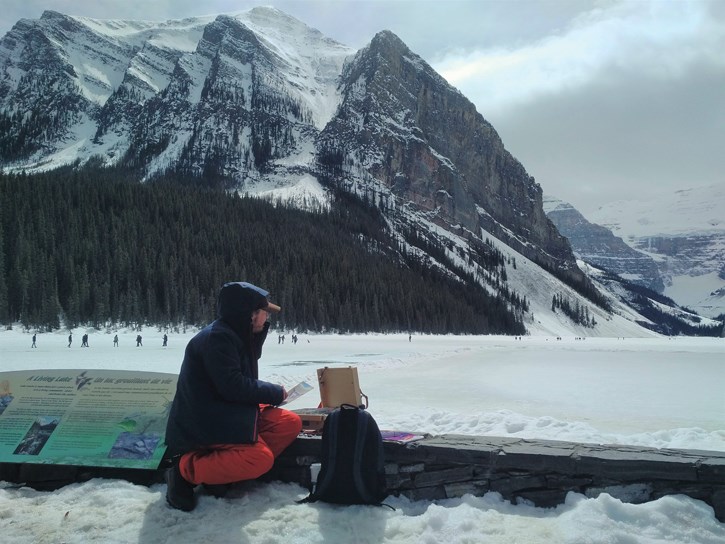Climate change, said Gennadiy Ivanov, and its resulting impacts people are experiencing around the world, is front and centre in the minds and work of many artists these days.
Ivanov, an accomplished and respected artist who grew up in Belarus, he now makes his home where he runs a gallery in Norwich, U.K. (200 kilometres northeast of London).
In deciding how he could best interpret the realities of Earth’s warming climate as part of his artwork, Ivanov reached out to one of the world’s foremost research centres focused on studying climate change. It was his connection with Trevor Davies, professor emeritus with the School of Environmental Sciences at the University of East Anglia in Norwich that brought him to the Canadian Rockies.
“Lots of artists are trying to communicate climate change. I’m trying to find my own approach,” Ivanov said. “I need to connect with the scientists to do it the right way.”
Through conversations with Davies, Ivanov came to know John Pomeroy, director of the Global Water Futures Program, the largest university-led freshwater research project in the world. Pomeroy is also director of the University of Saskatchewan’s Centre for Hydrology and its Canmore-based Cold Water Laboratory.
As part of a research mission to gather information and inspiration for his upcoming exhibit titled Transitions: Ice-Water-Cloud, last month Ivanov accompanied Davies on a visit to the Bow Valley.
They toured several research sites running under Pomeroy’s direction including snow hydrology study sites at Fortress Mountain in Kananaskis, and also glacier sites along the Icefields Parkway where researchers have studied the Canadian Rockies’ melting glaciers for decades.
Prior to the Rockies, Ivanov visited Pomeroy and colleagues’ research sites during the snow-melt season in the Yukon’s Caribou Creek, Wolf Creek and Kluane Lake areas. There they witnessed profound changes as melting permafrost causes the land to slump into thermokarst.
For Ivanov to visit these sites was essential and invaluable toward being able to communicate climate change through his art, and to understand the essential work scientists carry out to learn what is changing, and how.
“It’s important to me if this project goes ahead that it has excellent science,” Davies said. “It’s important for Gennadiy to see science in a visual way. That’s why we visited parts of Canada where climate change is very pronounced.”
In Wolf Creek, they witnessed bushes growing further north than they have before. They saw areas burnt by wildfires, which are exacerbated by warming temperatures and precipitation patterns. Temperatures in Inuvik rose to record highs this winter, and the Yukon snowpack was just 48 per cent of its historical average with the melt beginning in March, several weeks ahead of schedule.
“That snow has never melted before April, records go back to the early 1900s,” Pomeroy said.
Ivanov also learned how Kluane Lake has dropped 1.6 metres since the Kaskawulsh Glacier melted so far back in 2016 that within a few days it ceased to feed the Slims River, which flowed into the lake and ultimately into the Bering Sea. The glacier now drains into an entirely different watershed, the Alsek River, which empties into the Gulf of Alaska. The regional environmental effects – the Slims River delta is now dust and rocks and dirt – have altered the lives of local Kluane First Nation members, who watched their traditional fishing waters change drastically overnight.
Meanwhile, Pomeroy added, Saskatchewan is experiencing grass fires while Quebec and New Brunswick endure severe floods. The effects of climate change are being felt in his home too, Ivanov said.
“Why I started to do this, where I’m living now there are big floods and a lot of coastal erosion,” Ivanov said. “The Norfolk coastline together with the other bits of British and Dutch coastlines are seeing sea level rise. The storms are most intense, and the soft geology of the coastline leaves erosion.”
As they travelled, Ivanov created sketches that he will develop into major oil, acrylic and mixed media paintings. He also met with Anne Ewen, curator of art and heritage at the Whyte Museum of the Canadian Rockies in Banff to discuss a potential exhibit there. While no agreement has yet been signed, Ewen said the Museum is interested and looked forward to moving ahead with the project.
As Ivanov develops his artwork, Pomeroy and Davies will work with him to ensure there is a strong and clear science message in each of his paintings.
“We want to make sure the strong science narrative is there,” Pomeroy said. “We’re exploring how we can explicitly include science in Gennadiy’s paintings. We see this as a journey to get the message out, to raise awareness of how climate change is affecting people’s lives, right now, around the world including Canada.”
The entire project, Pomeroy added, is being planned to have a permanent home in the Canadian Rockies and will be imbedded with Global Water Futures in Canmore, with international links.
“We’re committed to developing a fusion of art and science,” Pomeroy said. “We think this will be the most ambitious and consistent way of starting this.”
For his part, Ivanov said his travels through northern and western Canada inspired him to incorporate natural elements in his impressionist landscapes, including wildfires, glacial ice, peaks obscured by smoke, collapsing permafrost, and to capture the pinks, reds and blues, greens and brown hues he witnessed. With some of his sketches, he applied soil right on the page to capture dirt. Along the way he recorded audio and video to help him reproduce some of the emotions he experienced.
“Growing up in Russia, I know what ice and snow means to me,” Ivanov said. “I used to like cold weather. Now I’m living in a place with very little snow and I lost that feeling. I immediately got it back when I came visiting here.”




